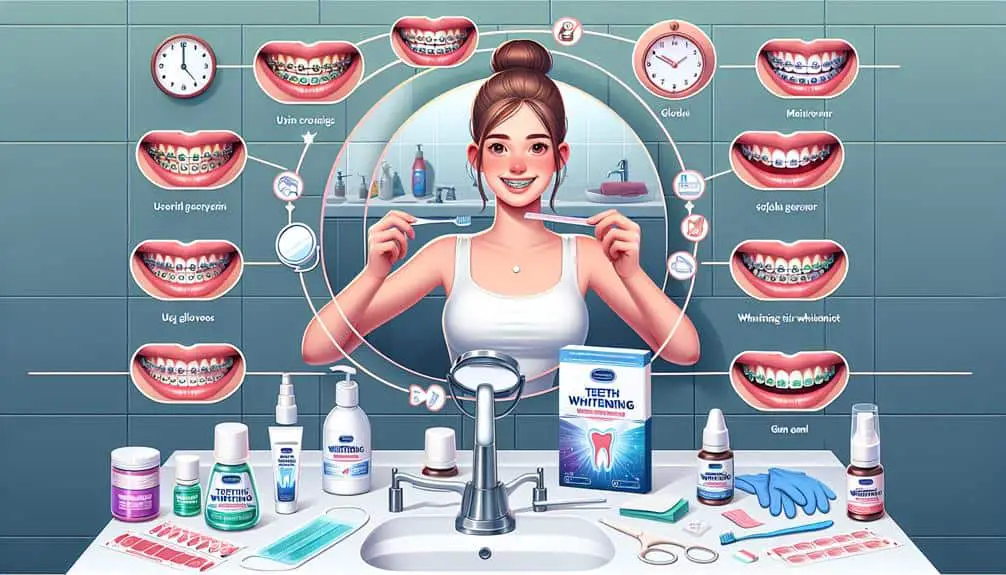To protect your enamel and braces while whitening, follow these top 10 precautions: Avoid whitening products with harsh chemicals, prioritize enamel protection, manage sensitivity, consult your orthodontist, use gentle toothpaste and fluoride rinses, brush correctly, be cautious of acidic foods, monitor gum health, maintain your orthodontic appliances, and follow product instructions. Taking these precautions will guarantee your safety and help you achieve the desired results while whitening with braces.
Key Points
- Consult your orthodontist before whitening to ensure safety with braces.
- Use fluoride toothpaste to protect enamel and strengthen teeth.
- Manage sensitivity with specialized toothpaste and enamel-strengthening products.
- Follow recommended whitening duration and frequency, respecting recovery time.
- Avoid acidic or staining foods to maintain a bright smile and brace integrity.
Potential Risks of Whitening With Braces
Before whitening your teeth while wearing braces, you should be aware of the potential risks associated with this process. Conducting a thorough risk evaluation is essential to understand the impact of whitening products on your teeth, especially when braces are involved.
While many whitening products are generally safe for teeth, those containing hydrogen peroxide or carbamide peroxide can potentially harm the enamel if not used correctly. The abrasive nature of some whitening agents may also pose a risk to the brackets and wires of your braces.
To mitigate these risks, it's important to prioritize enamel protection during the whitening process. Using a fluoride toothpaste or gel can help strengthen the enamel and reduce its susceptibility to damage from whitening agents. Additionally, consulting your orthodontist before starting any whitening treatment is advisable to make sure that it aligns with your overall orthodontic plan and doesn't compromise the integrity of your braces.
Sensitivity Management Strategies
To manage sensitivity effectively while whitening with braces, implementing specific strategies can help minimize discomfort and protect your oral health. Sensitivity relief is essential when undergoing whitening treatments, especially for those with braces.
One effective strategy is to use a toothpaste designed for sensitive teeth, which can help alleviate any discomfort experienced during the whitening process. These toothpastes typically contain ingredients that help soothe the nerves in your teeth, providing relief from sensitivity.
Another important aspect to take into account is enamel protection. Enamel protection can be achieved by using fluoride rinses or gels as recommended by your orthodontist or dentist. Fluoride helps strengthen the enamel and can reduce sensitivity caused by whitening agents.
Additionally, avoiding very hot or cold foods and drinks during the whitening process can also help minimize sensitivity.
Importance of Professional Consultation
For individuals looking to whiten their teeth while wearing braces, consulting with a professional is crucial to guarantee safe and effective treatment. When it comes to whitening safety, a professional consultation provides personalized guidance based on your specific dental situation. This guarantees that the whitening process won't interfere with your orthodontic treatment or cause any harm to your teeth or gums.
One of the key consultation benefits is the expertise that a professional can offer. A dentist or orthodontist will assess the current condition of your teeth and braces, considering any existing dental issues or sensitivities. This personalized evaluation enables them to recommend the most suitable whitening options that align with your orthodontic treatment plan.
Additionally, professional consultations often involve discussing proper aftercare to maintain the results of the whitening treatment and prevent any adverse effects. By seeking professional guidance, you can start your teeth whitening journey with confidence, knowing that your oral health is in good hands.
Brushing and Flossing Recommendations
Ensuring proper brushing and flossing techniques is vital when undergoing teeth whitening treatment with braces. Essential technique is key to maintain good oral hygiene and prevent staining during the whitening process.
When brushing with braces, use a soft-bristled toothbrush at a 45-degree angle to clean both the teeth and the brackets thoroughly. Make sure you brush each tooth surface, including the front, back, and chewing surfaces.
Flossing with braces can be challenging but is equally important. Use a floss threader or orthodontic floss to clean between teeth and under the wires. Regular flossing helps remove food particles and plaque buildup that can hinder the whitening process.
Choosing the right products is also pivotal. Opt for fluoride toothpaste to strengthen enamel and reduce sensitivity caused by whitening products. Mouthwashes containing hydrogen peroxide can aid in whitening but should be used in moderation.
Consider investing in an electric toothbrush to ensure a more thorough clean while being gentle on your braces. By following these recommendations and using the recommended products, you can achieve a brighter smile without compromising your orthodontic treatment's integrity.
Duration and Frequency Considerations
Considering the effectiveness of the whitening treatment, it's essential to establish appropriate durations and frequencies for best results while wearing braces. When whitening with braces, it's vital to be mindful of the whitening duration and frequency to avoid damaging the braces or causing sensitivity in the teeth. Here are some key points to keep in mind:
- Whitening duration: While wearing braces, it's recommended to follow the instructions provided with the whitening product carefully. Typically, the duration of each whitening session should be shorter than when not wearing braces to prevent uneven whitening or damage to the braces.
- Frequency: The frequency of whitening sessions should be spaced out to give your teeth and gums time to recover. Overdoing it can lead to increased sensitivity and potential damage to the braces. It's generally advisable to consult with your orthodontist to determine the safest frequency for your specific case.
- Braces compatibility: Not all whitening products are suitable for use with braces. Confirm that the product you choose is compatible with braces to prevent any adverse effects on the brackets or wires. Consulting with your orthodontist before starting any whitening treatment is always a good idea to ensure it's safe for your braces.
Avoidance of Acidic or Staining Foods
To maintain the integrity of your braces and preserve the whitening effects, it's important to be cautious about consuming acidic or staining foods**** during your whitening treatment. Acidic foods like citrus fruits, tomatoes, and vinegar can erode the enamel of your teeth, making them more susceptible to staining and reducing the effectiveness of the whitening treatment. Staining foods such as coffee, tea, red wine, and berries can discolor your teeth and counteract the whitening results you're aiming for.
During your whitening treatment, it's advisable to adhere to dietary restrictions that promote the longevity of your braces and enhance the whitening process. Opt for non-acidic fruits like bananas and apples, and choose white meats over red meats to minimize staining. Incorporating more water into your daily routine can help wash away food particles that may lead to discoloration.
Monitoring Gum Health During Whitening
Observing your gum health during the whitening process is vital to ensure the overall well-being of your oral cavity. It's important to pay attention to any signs of gum sensitivity, as whitening treatments can sometimes lead to increased sensitivity in the gums. Here are some key points to keep in mind when monitoring your gum health during whitening:
- Regularly check for any signs of gum irritation or sensitivity: Keep a close eye on your gums for any redness, swelling, or discomfort. If you experience any of these symptoms, discontinue the whitening treatment and consult your orthodontist.
- Maintain excellent oral hygiene: Proper oral hygiene is essential when undergoing whitening with braces. Brush and floss regularly to prevent plaque buildup and maintain the health of your gums.
- Use a soft-bristled toothbrush: Opt for a soft-bristled toothbrush to avoid causing any additional irritation to your gums while whitening. Gentle brushing techniques can help protect your gum health throughout the whitening process.
Proper Maintenance of Orthodontic Appliances
Proper care and maintenance of your orthodontic appliances are essential to guarantee effective treatment and prevent complications. Consistent appliance care is vital to make sure that your braces or aligners function correctly throughout your whitening treatment. Always follow the orthodontist's instructions regarding the cleaning and handling of your appliances. Regularly inspect your braces or aligners for any signs of damage or wear, and contact your orthodontist if you notice anything unusual.
In addition to appliance care, maintaining excellent oral hygiene is paramount when undergoing whitening with braces. Brush your teeth after every meal and floss daily to prevent plaque buildup and maintain the health of your teeth and gums. Using a fluoride mouthwash can further help in preventing cavities and maintaining overall oral health.
Adherence to Whitening Product Instructions
Make sure you carefully follow the guidelines given for the whitening products to maximize the effectiveness of your treatment while wearing braces. When using whitening gel with braces, proper application is essential.
Here are some key points to keep in mind:
- Whitening Gel Application: Follow the recommended amount of gel to apply on your teeth. Avoid excess application as it can lead to uneven whitening and potential gum irritation.
- Overnight Wear Restrictions: Check the instructions regarding overnight wear. Some whitening products aren't meant to be worn overnight, especially when wearing braces, as this can affect the integrity of both the braces and the whitening treatment.
- Duration of Treatment: Pay attention to the duration of each treatment session. Overusing whitening products can damage tooth enamel and increase tooth sensitivity, which can be aggravated by the presence of braces.
Post-Whitening Care for Braces
Upon finishing your whitening treatment with braces, make sure you follow specific post-whitening care instructions to maintain the results and protect your braces. Post-treatment maintenance is essential to prevent discoloration and safeguard your enamel. After whitening, continue to care for your braces and teeth by following a consistent oral hygiene routine. Brush your teeth at least twice a day with a soft-bristled toothbrush and fluoride toothpaste. Floss daily to remove any plaque or food particles that could lead to staining. Additionally, pay attention to your retainer care if you wear one. Clean your retainer as instructed by your orthodontist to avoid bacteria buildup and maintain its clarity.
To prevent discoloration, avoid consuming dark-colored foods and beverages such as coffee, tea, red wine, and berries. Rinse your mouth with water after consuming these items to reduce the risk of staining. Moreover, consider using a straw when drinking beverages that may stain your teeth. Enamel protection is essential, so be mindful of acidic foods and drinks that can weaken enamel. If you experience any sensitivity after whitening, consult your orthodontist for recommendations on enamel-strengthening products. By following these post-whitening care tips, you can prolong the results of your treatment and keep your braces in excellent condition.
Frequently Asked Questions
Can I Still Eat My Favorite Foods While Whitening With Braces?
You can still enjoy your favorite foods while whitening with braces. However, be mindful of staining agents like coffee or berries. Brush and floss after eating to prevent discoloration. Regular dental check-ups can also help maintain your bright smile.
How Long Should I Wait Before I Can Start Whitening My Teeth After Getting Braces?
Before whitening with braces, wait until they're off to avoid potential risks. Professional recommendations suggest waiting at least 6 months post-braces. Alternative options like professional whitening treatments can provide safer and more effective results.
Is It Safe to Use DIY Whitening Remedies With Braces?
When using DIY whitening remedies with braces, it's important to seek professional advice to avoid potential damage. Sensitivity concerns are heightened with braces. Prioritize your oral health and consult your orthodontist before attempting any at-home whitening treatments.
Will Whitening With Braces Affect the Color of the Brackets or Wires?
Whitening with braces can potentially affect the color of the brackets or wires due to the chemicals used in the process. Bracket discoloration and wire staining may occur, so it's important to follow precautions to minimize these risks.
Can I Continue Using Whitening Products After My Braces Are Removed?
After braces removal, you can resume using whitening products. However, it's crucial to consult with a dental professional for post-braces maintenance and to guarantee whitening longevity. Professional guidance will help achieve peak whitening results.




